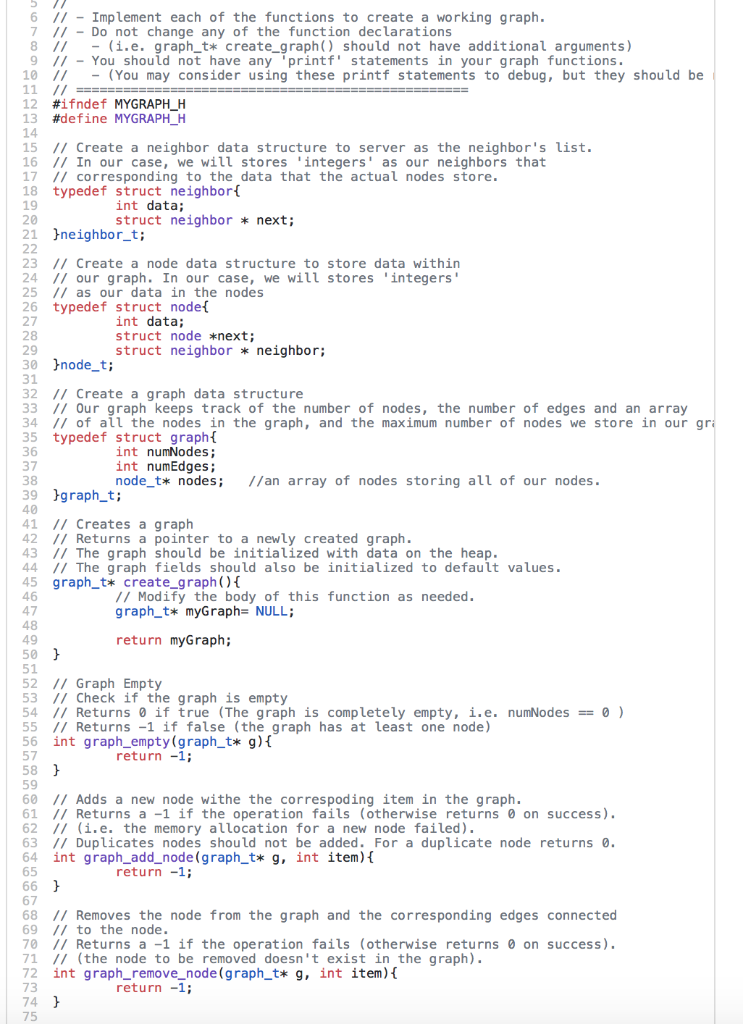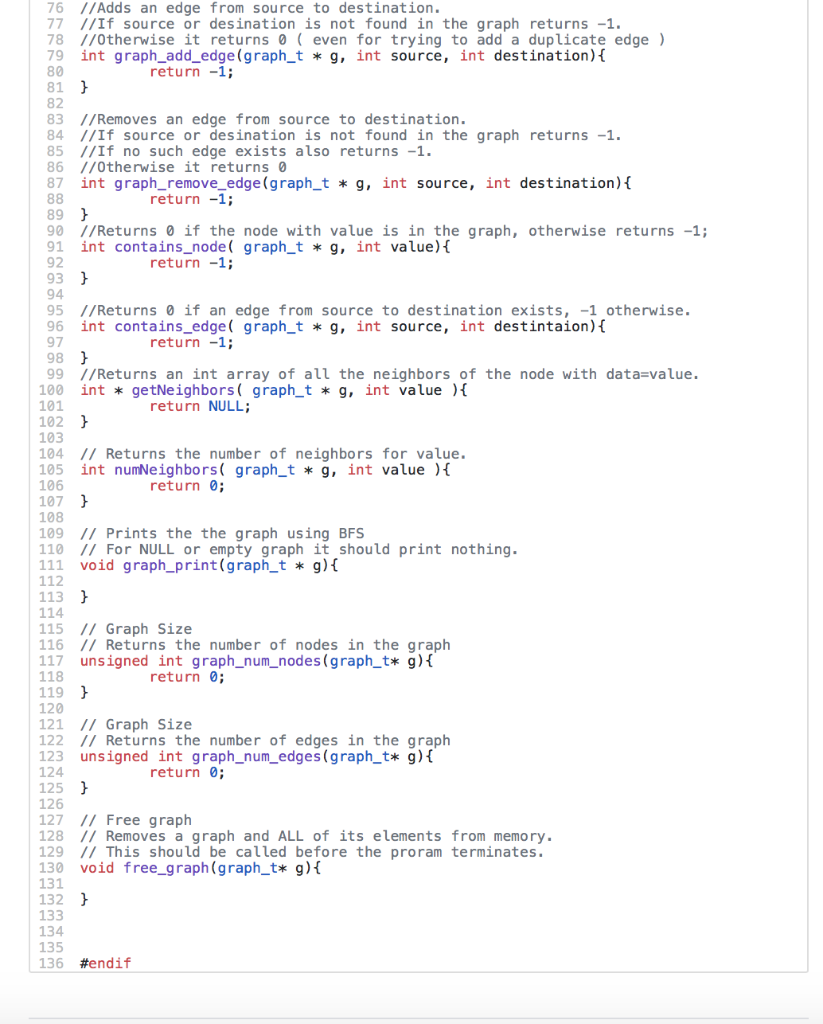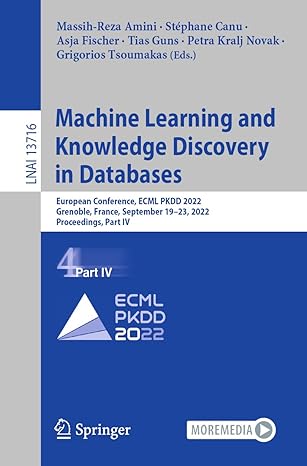Answered step by step
Verified Expert Solution
Question
1 Approved Answer
*** Implement the following in C : **** Copy Pasteable: // - Implement each of the functions to create a working graph. // - Do
*** Implement the following in C : ****


Copy Pasteable:
// - Implement each of the functions to create a working graph. // - Do not change any of the function declarations // - (i.e. graph_t* create_graph() should not have additional arguments) // - You should not have any 'printf' statements in your graph functions. // - (You may consider using these printf statements to debug, but they should be removed from your final version) // ================================================== #ifndef MYGRAPH_H #define MYGRAPH_H // Create a neighbor data structure to server as the neighbor's list. // In our case, we will stores 'integers' as our neighbors that // corresponding to the data that the actual nodes store. typedef struct neighbor{ int data; struct neighbor * next; }neighbor_t; // Create a node data structure to store data within // our graph. In our case, we will stores 'integers' // as our data in the nodes typedef struct node{ int data; struct node *next; struct neighbor * neighbor; }node_t; // Create a graph data structure // Our graph keeps track of the number of nodes, the number of edges and an array // of all the nodes in the graph, and the maximum number of nodes we store in our graph. typedef struct graph{ int numNodes; int numEdges; node_t* nodes; //an array of nodes storing all of our nodes. }graph_t; // Creates a graph // Returns a pointer to a newly created graph. // The graph should be initialized with data on the heap. // The graph fields should also be initialized to default values. graph_t* create_graph(){ // Modify the body of this function as needed. graph_t* myGraph= NULL; return myGraph; } // Graph Empty // Check if the graph is empty // Returns 0 if true (The graph is completely empty, i.e. numNodes == 0 ) // Returns -1 if false (the graph has at least one node) int graph_empty(graph_t* g){ return -1; } // Adds a new node withe the correspoding item in the graph. // Returns a -1 if the operation fails (otherwise returns 0 on success). // (i.e. the memory allocation for a new node failed). // Duplicates nodes should not be added. For a duplicate node returns 0. int graph_add_node(graph_t* g, int item){ return -1; } // Removes the node from the graph and the corresponding edges connected // to the node. // Returns a -1 if the operation fails (otherwise returns 0 on success). // (the node to be removed doesn't exist in the graph). int graph_remove_node(graph_t* g, int item){ return -1; } //Adds an edge from source to destination. //If source or desination is not found in the graph returns -1. //Otherwise it returns 0 ( even for trying to add a duplicate edge ) int graph_add_edge(graph_t * g, int source, int destination){ return -1; } //Removes an edge from source to destination. //If source or desination is not found in the graph returns -1. //If no such edge exists also returns -1. //Otherwise it returns 0 int graph_remove_edge(graph_t * g, int source, int destination){ return -1; } //Returns 0 if the node with value is in the graph, otherwise returns -1; int contains_node( graph_t * g, int value){ return -1; } //Returns 0 if an edge from source to destination exists, -1 otherwise. int contains_edge( graph_t * g, int source, int destintaion){ return -1; } //Returns an int array of all the neighbors of the node with data=value. int * getNeighbors( graph_t * g, int value ){ return NULL; } // Returns the number of neighbors for value. int numNeighbors( graph_t * g, int value ){ return 0; } // Prints the the graph using BFS // For NULL or empty graph it should print nothing. void graph_print(graph_t * g){ } // Graph Size // Returns the number of nodes in the graph unsigned int graph_num_nodes(graph_t* g){ return 0; } // Graph Size // Returns the number of edges in the graph unsigned int graph_num_edges(graph_t* g){ return 0; } // Free graph // Removes a graph and ALL of its elements from memory. // This should be called before the proram terminates. void free_graph(graph_t* g){ } #endif
6 I1-Implement each of the functions to create a working graph I1-Do not change any of the function declarations (i.e. graph t* create_graph) should not have additional arguments) 9 II-You should not have any 'printf' statements in your graph functions. - (You may consider using these printf statements to debug, but they should be 12 #ifndefMYGRAPH_A 13 #define MYGRAPHH 14 15 II Create a neighbor data structure to server as the neighbor's list 16 // In our case, we will stores integers' as our neighbors that 17 // corresponding to the data that the actual nodes store. 18 typedef struct neighborf 19 20 21 neighbor_t; int data struct neighbor next; 23 I/Create a node data structure to store data within 24 // our graph. In our case, we will stores integers" 25 I/ as our data in the nodes 26 typedef struct node 27 28 29 30 node_t; 31 32 II Create a graph data structure 33 // 0Our graph keeps track of the number of nodes, the number of edges and an array 34 I/ of all the nodes in the graph, and the maximum number of nodes we store in our gra 35 typedef struct graph 36 37 38 9 graph_t; 40 1 I/ Creates a graph 42 // Returns a pointer to a newly created graph. 43 I1 The graph should be initialized with data on the heap. 44 1/ The graph fields should also be initialized to default values 45 graph_t* create_graph) 46 47 48 49 50 51 52 II Graph Empty 53 I/ Check if the graph is empty 54 I1 Returns 0 if true (The graph is completely empty, i.e. numNodes) 55 I/ Returns-1 if false (the graph has at least one node) 56 int graph_empty (graph_t* g)f 57 58 59 60 // Adds a new node withe the correspoding item in the graph. 61 I/ Returns a -1 if the operation fails (otherwise returns on success) 62 11 (i.e. the memory allocation for a new node failed) 63 Duplicates nodes should not be added. For a duplicate node returns 0 64 int graph_add_node (graph_t* g, int item) 65 int data struct node next; struct neighbor neighbor; int numNodes; int numEdges node t* nodes; //an array of nodes storing all of our nodes. // Modify the body of this function as needed. graph_tmyGraph- NULL; return myGraph; return-1 return-1; 68 I/ Removes the node from the graph and the corresponding edges connected 69 11 to the node. 70 I/ Returns a -1 if the operation fails (otherwise returns 0 on success) 71 11 (the node to be removed doesn't exist in the graph) 72 int graph_remove_node (graph_t* g, int item) 73 74 75 return-1; 76 //Adds an edge from source to destination. 77 //If source or desination is not found in the graph returns -1. 78 //0therwise it returns even for trying to add a duplicate edge) 79 int graph_add_edge(graph_t * g, int source, int destination) 80 return-1; 81 82 83 //Removes an edge from source to destination. 84 //If source or desination is not found in the graph returns-1 85 //If no such edge exists also returns -1. 86 //0therwise it returns0 87 int graph_remove_edge(graph t return-1; g, int source, int destination) 89 90 //Returns 0 if the node with value is in the graph, otherwise returns-1; 91 int contains node( graph_t* g, int value) 92 return -1; 93 94 95 //Returns 0 if an edge from source to destination exists, -1 otherwise. 96 int contains_edge( graph t * g, int source, int destintaion) 97 return-1; 98 99 //Returns an int array of all the neighbors of the node with data-value. 100 int *getNeighbors( graph t *g, int value 101 102 103 return NULL; 104 11 Returns the number of neighbors for value. 105 int numNeighbors( graph_t g, int value ) 106 107 108 return 0; 189 17 Prints the the graph using BFS 110 I/ For NULL or empty graph it should print nothing. 111 void graph_print(graph_t *g) 112 113 114 115 / Graph Size 116 I/ Returns the number of nodes in the graph 117 unsigned int graph_num_nodes(graph_t* g) 118 119 120 121 II Graph Size 122 // Returns the number of edges in the graph 123 unsigned int graph_num_edges(graph t* g) 124 125 126 127 I/ Free graph 128 II Removes a graph and ALL of its elements from memory 129 II This should be called before the proram terminates. 130 void free_graph (graph t* g) 131 132 133 134 135 136 #endif return 0; return 0Step by Step Solution
There are 3 Steps involved in it
Step: 1

Get Instant Access to Expert-Tailored Solutions
See step-by-step solutions with expert insights and AI powered tools for academic success
Step: 2

Step: 3

Ace Your Homework with AI
Get the answers you need in no time with our AI-driven, step-by-step assistance
Get Started


